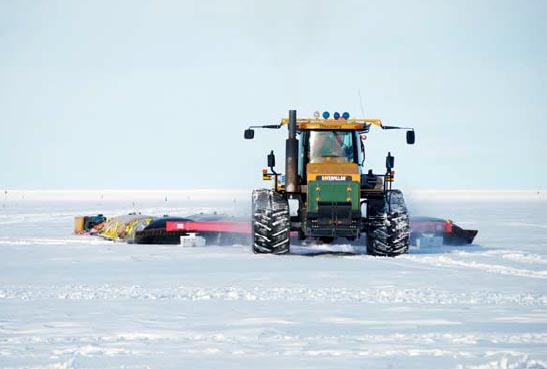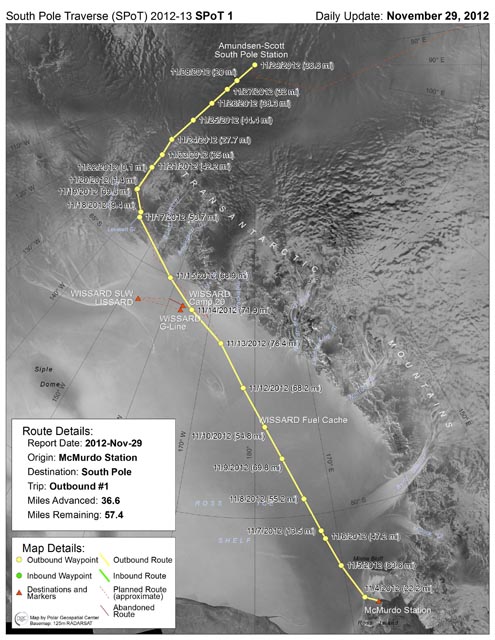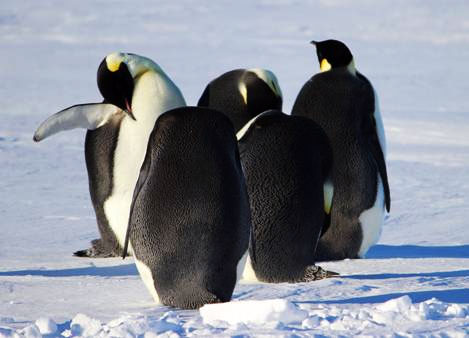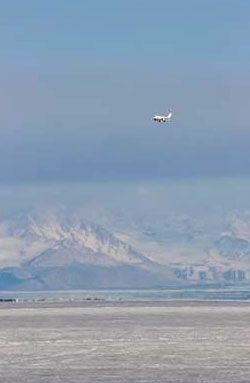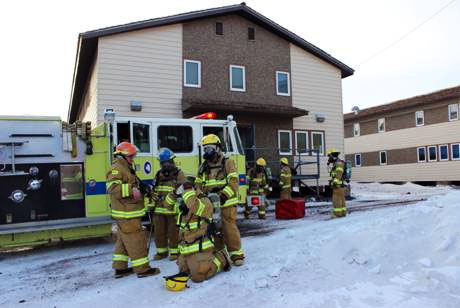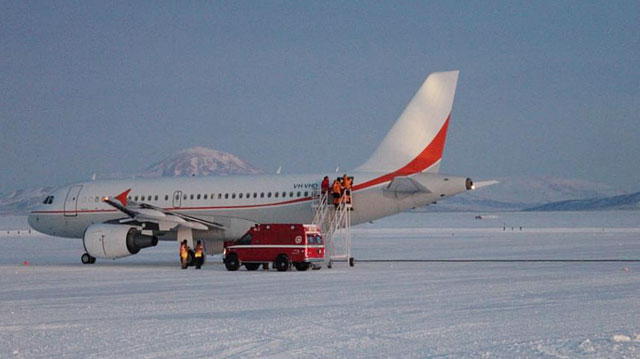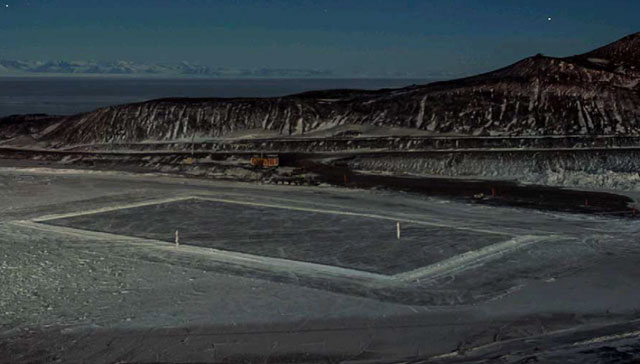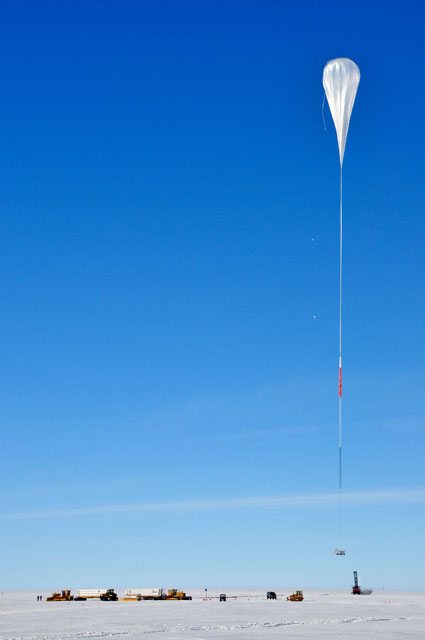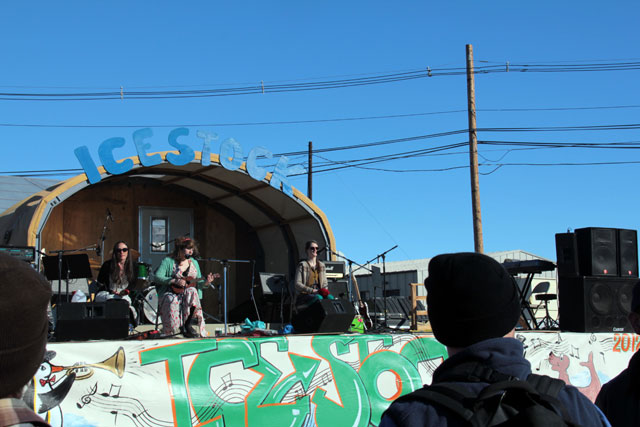|
McMurdo Station Archives - 2012 McMurdo Station's infamous dishwasher receives proper sendoffPosted December 7, 2012
The kitchen at McMurdo Station Also in the galley are the blue-shirted stewards who deliver the prepared food to the hot food line, scrub the pots, run the dishwasher, mop the floors and maintain cleanliness of the area, amongst a myriad of other duties. The position was changed this year to include food-service responsibilities on some days and janitorial services throughout the station on others. It’s one of the toughest jobs on station, usually filled by those just seeking the excitement of getting to Antarctica. Most have bachelor’s degrees, and more than a few have graduate degrees. They endure thankless hours of smelling like food and dealing with impatient diners. They commiserate with each other, and through the long hours, your coworkers become your family. And when they lose a member of this family, they mourn together. Bertha had difficulty maintaining her pH, and she was inconsistently performing at work. Measures were taken to improve her performance, and experts were called in, but finally it was decided that Bertha the dishwashing machine was to be replaced. She may not have been flesh and bone, but Bertha was indeed part of the family — love her or hate her. And hate her some of the kitchen staff did, for she was not always kind to her attendants. She would unexpectedly spew slime on them or cover them in disgusting film from having to clean her. The stewards saw it to memorialize her before she was removed from the dish room. So, on one bright Antarctic evening in October, mourners came and went, dressed for the occasion: the wake for Bertha the dish machine. One by one, each mourner went into the dish room to say goodbye. Notes where written and attached to her about the staff's favorite memories. Words of kindness were sent in from afar, via Facebook, for the event. Eulogies were read, her favorite songs played, and there was even a group dance performed in her honor. Finally, “Amazing Grace” was sung and the group turned to Gallagher’s, the local pub, for further reflections on her life. It was a fitting goodbye. Elsewhere on station, the more serious activities of scientific research are in full swing, with more than 50 science groups on station by mid-November. Helicopters are seen overhead delivering workers and supplies to camps. Dive huts are active with divers gathering research from the frosty depths of the Ross Sea. The airfields continue to be abuzz with flights. Farther afield from McMurdo Station, the first South Pole Traverse tractor train arrived at the South Pole Station Emperor penguins make guest appearance at McMurdo StationPosted October 26, 2012
Many at McMurdo Station It was certainly a pleasant distraction in the daily routine, as many darted outside, cameras in hand, to the sea ice to get a closer look. I missed the penguins, as they traveled past town, but was able to spot them later near Pegasus, as they sat grooming themselves. Getting a close look was a real treat, and with the help of a zoom lens, a few great shots were taken. Daylight is taking over more and more, and hope for seeing an aurora has dwindled. Sunsets still continue to be breathtaking, and the weather remains cold and variable. Some warming temperatures have arrived, offering a challenge to those working on the Annual Sea Ice Runway. Much effort was put into the runway, which traditionally is the airfield used for the early part of the summer season because it’s close to the station. The job was completed and ready for use for the first U.S. Air Force C-17 Globemaster III The key in building the ice runway is to get the snow removed and the ice exposed. The snow acts as insulation, but once it is removed, the ice will cool further and grow more quickly. Colder temperatures help the ice grow, but warmer temperatures lately have proven a challenge in maintaining it. A number of the C17 landings were made at Pegasus on the permanent ice shelf about 14 miles away. However, it is expected that the ice runway will be fully functional until at least Thanksgiving. The station recreational activities have begun to pick up, with the last events before the beginning of the summer field season including a Hawaiian-themed dinner and a great party with live bands hosted by the Carpenter Shop. Now, with the beginning of the main field season, recreational activities are in full swing, from ping-pong to dodge-ball tournaments. Sun, color and science return to McMurdo in AugustPosted September 21, 2012
August at McMurdo Station 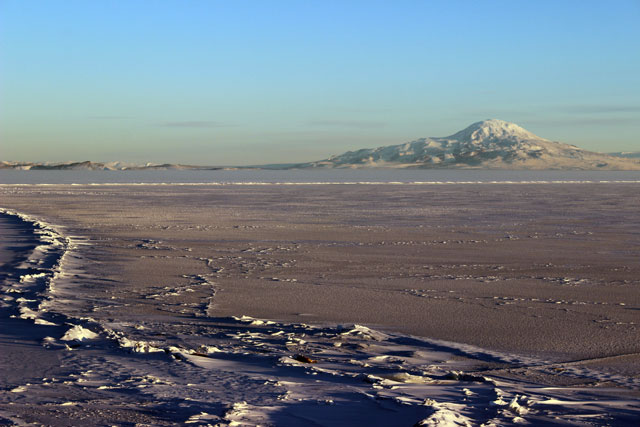
Photo Credit: Beth Jennings
Color returns to McMurdo Sound as summer approaches. Mount Discovery is seen in the distance.
The Crary Science and Engineering Center is showing increased activity, with four groups working on projects. One team, led by Xinzhao Chu A pair of researchers from Oregon State University Brad Buckley’s 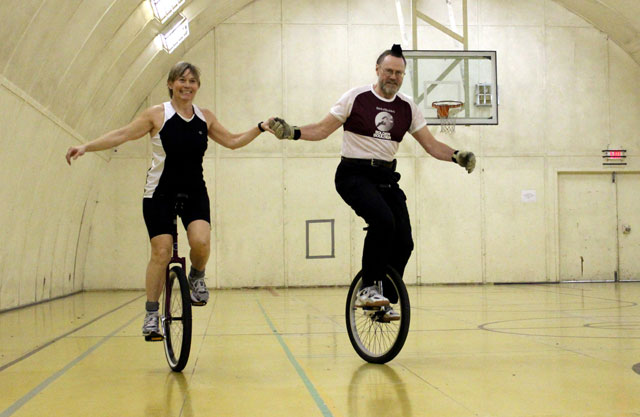
Photo Credit: Beth Jennings
Theresa Gilliland and Ray Sundby unicycle in the gym at McMurdo Station.
With the new season come some changes at the station. Plans are in the works for renovations to some of the dormitories. Work will begin this summer to refurbish and remodel — the “smell of fresh paint” — Building 155. The goal is to no longer have five to six people per room in that building and to keep occupancy to three per room maximum. There are plans to remodel one of the dorms for singles, and to eventually update many of the other dorms over the next several years. The social scene this time of year is slightly more active than winter, but much slower than the summer. Gallagher’s Bar is still popular on Saturday nights, particularly since Southern Exposure has not opened yet. American Night at Scott Base McMurdo pulls off medevac shortly before Winfly beginsPosted August 24, 2012
McMurdo Station The Fleet Operations team ensured the airfield at Pegasus White Ice Runway The medical evacuation, which also brought in some mail and highly coveted freshies, came with only about 11 days before the beginning of Winfly (winter fly-in). Station operations are going full steam in anticipation of the arrival of more than 300 scientists and support staff this month. Multiple departments continue to be involved in opening buildings that have been closed all winter and de-winterizing vehicles that have not been driven since February or March. Construction of the ice pier in Winter Quarters Bay has been progressing on schedule, with a layer of cable reinforcement installed in late July and pours being made every two to four days. If all continues to go well, the pier may be able to support vessel operations in February. McMurdo held its own version of the Olympics to coincide with the games being held in London. Several teams formed their own “countries,” complete with flags and costumes, and competed in events such as the cotton ball pass, twister, hula hoop, and a race wearing extreme cold weather gear. While the team from Scott Base 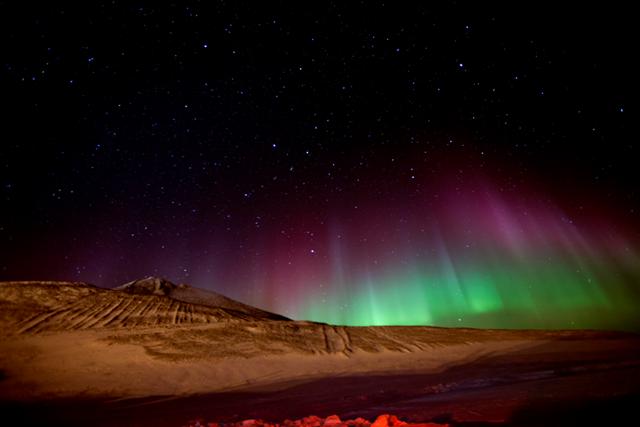
Photo Credit: Devin Stross/Antarctic Photo Library
An aurora near McMurdo Station during the 2012 winter.
The first weekend in August featured a special Ballpark dinner presented by the kitchen staff, complete with concession stand service (featuring hot dogs, hamburgers, pizza, pretzels, and ice cream), Wii baseball, and a small-scale baseball diamond in the dining room. The dinner was followed by the last open mic night of the winter season, which featured a full roster of musical talent from both McMurdo and Scott Base. Filming for the 48-hour film festival also took place the first weekend in August, with stations across Antarctica being invited to submit a short film featuring five specific elements chosen by last season’s winning stations. [See previous article — At the movies: McMurdo film fest draws record number of entries from 21 research stations around the Antarctic.] This year’s films had to include a queen as a character, a map of the station and a computer mouse, the sound of ice cracking, and the line of dialogue, “I’ll save you.” We’re all anxious to view the 27 films submitted by 20 stations representing 11 countries and vote for our favorites! Midwinter festivities highlight a busy June at McMurdoPosted July 20, 2012
Midwinter, that uniquely Antarctic holiday, was celebrated at McMurdo Station Although there are only 14 people occupying New Zealand’s Scott Base this winter, they graciously welcomed more than 70 plungers from McMurdo, who were crazy enough to think jumping into 28-degree Fahrenheit water in the middle of winter was a good idea. Thankfully, Mother Nature cooperated and turned off the wind machine, so the event was by all accounts a huge success. The Kiwis and all the McMurdo personnel who helped coordinate and support the event deserve a huge thank you for spending most of their day off helping everyone else have a fun and safe time. The annual Midwinter Dinner was a fun-filled evening. Numerous community members pitched in to design and create invitations, make decorations to fit the “Winter Skies” theme, help the kitchen with food preparation during the week leading up to the dinner, and coordinate setup and cleanup. [See previous article — Waiting for the sun: Antarctic research stations observe winter solstice.] The kitchen crew once again proved that they’re an insanely talented group, creating a sumptuous feast, featuring staff specialties such as crispy duck skin, salmon Wellington, and spring rolls with goodies from the greenhouse. The gourmet dessert spread included an assortment of homemade marshmallows and cakes, complete with a chocolate fondue fountain and real ice cream. After dinner, everyone enjoyed hamming it up for pictures in the photo booth and showing off their moves on the dance floor. The Midwinter Race and Relay was delayed by two weeks due to unfavorable weather on the original date. When race day finally came, 31 brave racers, including three relay teams, showed up to tackle the mile-long course through town. Despite cold temperatures and a stiffer-than-desired breeze, the racers proved their toughness in completing the course and enjoyed some snacks and hot beverages in the Coffeehouse as a reward for their efforts. It’s not all fun and games at McMurdo. By the end of June, enough ice had finally built up in Winter Quarters Bay to begin constructing the ice pier. Fleet Operations jumped into action, clearing the surface and building berms in preparation for the first pour on July 3. Two more pours have since been completed, so only time will tell whether we end up with a giant ice cube or a usable pier this year. [See previous stories — Without pier: Floating dock from McMurdo Station found locked in sea ice and Strong finish: Successful cargo operation completes challenging logistics season.] All the activity on the ice is just another reminder that winter is drawing to a close, with the first flight of Winfly (winter fly-in) due to arrive on Aug. 20, bringing much anticipated fresh fruit and vegetables, mail, and “orange people” among our pale-faced midst. These remaining weeks will bring the conclusion of the pool league, more gatherings to watch TV shows and movies, the 24-hour Film Festival, an Antarctic Service Medal ceremony, the opening of buildings around station, and the return of the sun. Hope we can all find our sunglasses! Winter weather at McMurdo perfect excuse to play indoorsPosted June 22, 2012
Mother Nature has not been terribly cooperative for those wanting to participate in outdoor activities so far this winter at McMurdo Station Windy and cloudy conditions prevented the few brave souls who took a ride to Castle Rock on a stargazing trip from seeing much. A few hearty folks battled the elements on Memorial Day for a flag-raising ceremony, but the runners who signed up for the Mid-Winter run and relay didn’t fare as well; they will have to wait a couple of weeks as the race was postponed due to forecasted storms. 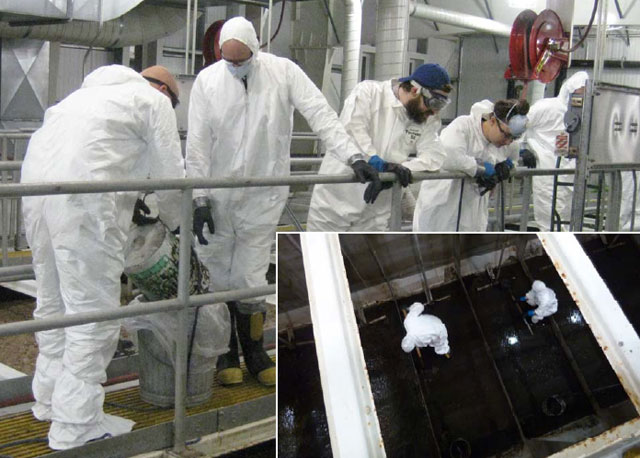
Photo Credit: Gracie Cole and Kricket Scheerer (inset)
Volunteers help clean the McMuro wastewater facility.
The darkness and cold has provided the perfect excuse to spend free time indoors, and a good crowd turned out when the library was transformed for a wine-tasting event. A variety of red and white wines that were not yet available in the store was offered for tasting, along with gourmet snacks provided by the kitchen. Tasters were also able to admire some of the eclectic art pieces that have been collected over the years in the library while enjoying acoustic music performed by many of the talented musicians on station. A successful Monday night lecture series has included separate travelogues on trips in Africa (by plane and overland truck), as well as a humorous tale of one worker’s journey from dorm to work center (including factoids of dubious historical accuracy). Additional presentations about work being done at McMurdo and New Zealand’s Scott Base Brendan Roberts, our lone winter-over science grantee, gave a presentation on the year-round research conducted by his group. The multi-year project uses LiDAR (Light Detection and Ranging) technology to measure middle and upper atmosphere temperatures, which can be indicators of climate change. Since the LiDAR is operated from Arrival Heights 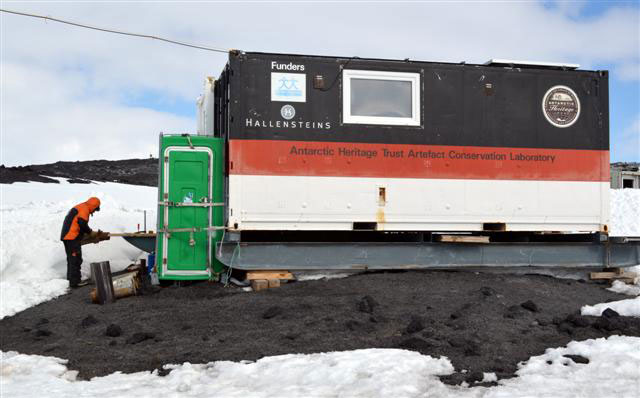
Photo Credit: Peter Rejcek/Antarctic Photo Library
The New Zealand Antarctic Heritage Trust lab at the Cape Evans site over the 2011-12 summer.
Two conservators from the New Zealand Antarctic Heritage Trust (NZAHT) The small population during winter offers the perfect opportunity to do some deep cleaning at the Wastewater Treatment Plant. Volunteers participated in a “poo dive” to help muck out two treatment trains not being used this winter. It was a group effort, as various departments, including EH&S, the Fire Department, Medical and Waste, were involved to make sure the operation went off without a hitch. The volunteers were fully suited up and spent time shoveling the accumulated gunk into buckets, which were hoisted to walkways overhead and then dumped into waste triwalls to be shipped out next year. By all accounts, they had a great time getting dirty in the name of community service. McMurdo enters winter maintenance modePosted May 25, 2012
The winter season at McMurdo Station Operations have continued as normal after the U.S. Antarctic Program Departments are keeping the station running and preparing for the upcoming summer science season by doing maintenance on equipment, receiving new materials that arrived via supply vessel and cargo flights at the end of summer, and getting organized for next season. On April 24, the sun dropped below the horizon for the last time until August 19. Recreation trips to Castle Rock, Arrival Heights and the Pegasus crash site were organized to view the event. We enjoyed some beautiful sunsets in the weeks that followed, providing the last glimpses of light to be seen until the glow starts forming on the horizon again as the end of winter approaches. The amazing kitchen staff also provided a sumptuous Italian feast to celebrate the final sunset, complete with fresh salad, an impressive variety of pasta dishes, and gourmet desserts. Those who were here last year may be experiencing déjà vu as the old ice pier is once again threatening to drift away after several cables attaching it to shore broke loose. It looked like we had a good start for the new ice pier to be built this winter until the ice in Winter Quarters Bay was blown out by a storm in early May, so we’re back to square one. Despite the occasionally gusty conditions, a new record high temperature for May of 30 degrees Fahrenheit was set, making it feel more like summer than winter for a brief time. When we’re not busy working, various departments have helped spice up the social scene. The Berg Field Center, Mechanical Equipment Center, and Aircraft Ground Equipment departments all hosted parties, with live music showcasing some of McMurdo’s local talent, and the Vehicle Maintenance Facility held a horseshoes tournaments. Our intrepid recreation coordinator, with the help of the community, has made sure plenty of options for fun are available, including movie/TV nights, card games, dancing lessons, bingo, trivia, karaoke, burrito bar and more. The firefighters have also been showing off their shiny new engines, offering rides in the trucks and tours of the Firehouse on Sundays. Station manager Harry House led several trips to build igloos along the Castle Rock Loop trail, resulting in two complete igloos and a partially finished third one. Camping trips to the igloos should start soon. Matt Nelson has also been leading frequent tours to the Discovery Hut, sharing some Antarctic history with the community and documenting a variety of names inscribed on the walls by early explorers. Science ramps down as ship operations power up at McMurdoPosted February 17, 2012
The new year at McMurdo Station More than 40 science groups were being supported from McMurdo to begin the year, with more than 70 people using the Crary Lab and nearly 100 working at field camps. The second of two Long Duration Balloons Of course, what would a field season be without penguin research? Scientist David Ainley 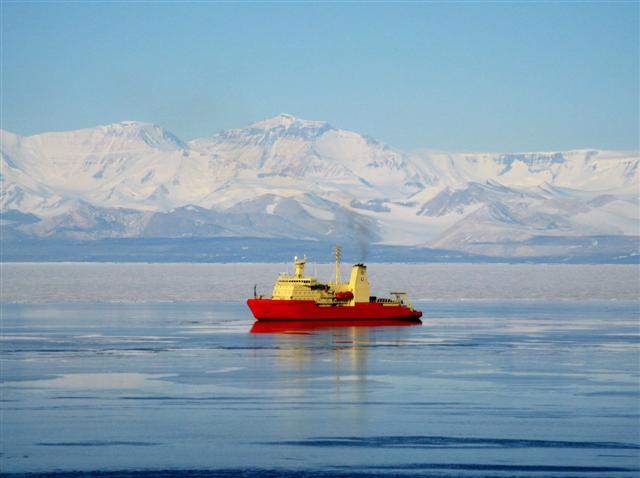
Photo Credit: Holly Gingles/Antarctic Photo Library
The research vessel NATHANIEL B. PALMER in McMurdo Sound at the end of science cruise in February 2012.
Not far behind Adélies in the charismatic megafauna category are Weddell seals. A research team led by Dan Costa Seals are outfitted with autonomous sensors that collect oceanographic data as they swim. The data are transmitted back to the Long Marine Lab Weather is always a topic in Antarctica, and the month started off where most of the end of 2011 had left off — unseasonably warm. So warm, in fact, that U.S. Air Force C-17 flights from Christchurch started arriving and leaving in the early morning hours, when temperatures are at their coldest. The relatively warm temperatures also made it difficult to maintain the snow roads from Ross Island to the airfield. However, the brief Antarctic summer started to cool off as the month wore on. That was particularly good news for the rapidly deflating ice pier, which had never properly solidified during the winter and early summer. [See previous article — Without pier: Floating dock from McMurdo Station found locked in sea ice.] While it would eventually be pulled out of the way for the cargo offload in February, it was stable enough to support foot traffic for the fuel offload at the end of January. The Russian icebreaker Vladimir Ignatyuk arrived in McMurdo Sound and quickly cut a channel for the fuel tanker Maersk Peary, which arrived at the wharf on Jan. 27. Due to the instability of the ice pier, the ship was moored to bollards on both sides of Winter Quarters Bay. The ship delivered more than seven million gallons of fuel, unloading the last drop in less than three days. Science rapidly ramped down throughout the month, as station personnel gathered their strength for the mid-February arrival of the cargo vessel, an intense, 24-hour-a-day operation made even more challenging because of the unavailability of the ice pier. Instead, the U.S. Army has come to the rescue with a modular pontoon causeway that will be built in place of the ice pier. The last flight of the season for McMurdo is scheduled for March 2. Holidays in McMurdo offer reprieve from stateside hustle and bustlePosted January 13, 2012
Many people who come to work at McMurdo Station 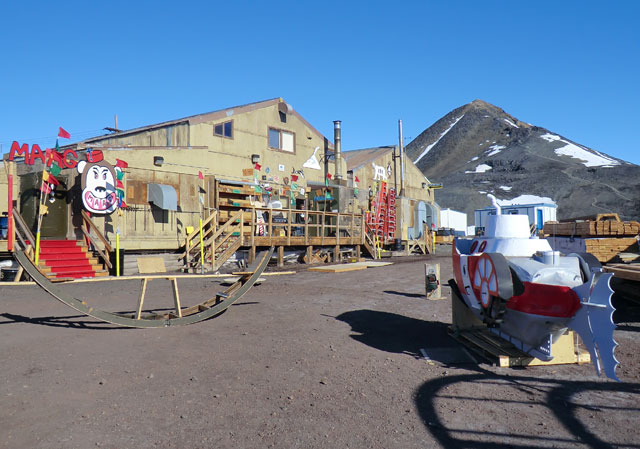
Photo Credit: Stephanie Prince
The McMurdo Alternative Art Gallery takes place every year at Christmas.
Instead of hustling through a maze of sweaty shoppers in an overcrowded mall, McMurdo residents perused homemade crafts at the season’s biggest craft fair in the town galley. No one had to stay up late wrapping last-minute presents on Christmas Eve; instead, people interacted with alternative art forms created by Antarctica’s finest craftsmen and artists at MAAG — the McMurdo Alternative Art Gallery. Each year, elves from McMurdo Station’s carpentry shop transform their workspace for the one-night art extravaganza. Artists gave the gift of creative expression this holiday season with exhibits ranging from an outdoor adult-sized seesaw to an enclosed bunk-sized sanctuary called “The Secret Cozy Place.” Alternative art projects abounded, as well as paintings, drawings, comics, metalworkings and a “get your own mug shot” photo booth. An eccentric fashion show and all-night dancing capped off the event. December wasn’t all fun and games, though. A lot of departments — from Fuels to Fleet Operations to Shuttles — put in hard work to make the transfer from the sea ice runway to Pegasus Airfield at the beginning of December. This year, a partially new route to Pegasus is being used, and although road conditions were rough at the beginning of the month, warm and sunny weather for much of December has led to a nicer, smoother ride for all those going back and forth to the runway. A nearly perfect weather pocket on Dec. 25 allowed the launch of the Cosmic Ray Electron Synchrotron Telescope (CREST) The CREST instrument is an electron and synchrotron detector suspended below the balloon. It will circle around the continent once or twice before falling back to Antarctica. This detector is an experimental design that will look for evidence of supernova events. People of McMurdo rang in the New Year in style listening to live music at IceStock, Antarctica’s biggest music festival. A chili cook-off got the event started out right, fueling concertgoers for six hours of music and dancing. Spicy chili, sunshine and a break from the wind allowed all to let loose and celebrate all the new things to come in 2012. |
Home /
Around the Continent /
McMurdo Station Archives - 2012
"News about the USAP, the Ice, and the People"



For USAP Participants |
For The Public |
For Researchers and EducatorsContact UsU.S. National Science FoundationOffice of Polar Programs Geosciences Directorate 2415 Eisenhower Avenue, Suite W7100 Alexandria, VA 22314 Sign up for the NSF Office of Polar Programs newsletter and events. Feedback Form |


